Transformative Resilience: An Overview of Its Structure, Evolution, and Trends
Abstract
1. Introduction
- How has transformative resilience positioned at the forefront of global initiatives on sustainable development, disaster risk reduction, and climate change adaptation?
- Which nations and organizations play the most active roles in defining and shaping transformative resilience paradigms?
- Which disciplines have served as the foundation for transformational resilience discourses across time, sectors, and contexts?
- What has changed in transformational resilience pathways throughout time, and what will be the crucial emphasis area in the future?
2. Research Methods and Materials
3. Results and Discussion
3.1. Publication Trends
3.2. Core Subjects, Journals and Authors
3.3. Research Subject Areas and Their Transformation
3.3.1. Subject Areas
3.3.2. Transformation of Research Subjects over Time
3.4. Literature Foundations
3.4.1. Leading Sources
3.4.2. Leading Documents
3.4.3. Leading Authors
4. Conclusions
- Mapping publication trends and assessing underlying initiatives in the relevant literature highlighting the importance of the transition toward transformative resilience;
- Identifying central subject areas, lead sources, authors, and the relevant knowledge and expertise that have shaped the field;
- Revealing the intellectual bases of the field within various but interconnected disciplines;
- Examining the development and evolutionary backgrounds of the field over time.
Supplementary Materials
Funding
Institutional Review Board Statement
Informed Consent Statement
Data Availability Statement
Conflicts of Interest
References
- Matyas, D.; Pelling, M. Positioning Resilience for 2015: The Role of Resistance, Incremental Adjustment and Transformation in Disaster Risk Management Policy. Disasters 2015, 39, s1–s18. [Google Scholar] [CrossRef] [PubMed]
- Thomalla, F.; Boyland, M.; Johnson, K.; Ensor, J.; Tuhkanen, H.; Swartling, Å.G.; Han, G.; Forrester, J.; Wahl, D. Transforming Development and Disaster Risk. Sustainability 2018, 10, 1458. [Google Scholar] [CrossRef]
- UNISDR. Making Development Sustainable: The Future of Disaster Risk Management. In Global Assessment Report on Disaster Risk Reduction; UNISDR: Geneva, Switzerland, 2015; ISBN 978-92-1-132042-8. [Google Scholar]
- Torabi, E.; Dedekorkut-Howes, A.; Howes, M. Adapting or Maladapting: Building Resilience to Climate-Related Disasters in Coastal Cities. Cities 2018, 72, 295–309. [Google Scholar] [CrossRef]
- Tanner, T.; Bahadur, A.; Moench, M. Challenges for Resilience Policy and Practice; UNISDR: Geneva, Switzerland, 2017. [Google Scholar]
- Asadzadeh, A.; Kötter, T.; Salehi, P.; Birkmann, J. Operationalizing a Concept: The Systematic Review of Composite Indicator Building for Measuring Community Disaster Resilience. Int. J. Disaster Risk Reduct. 2017, 25, 147–162. [Google Scholar] [CrossRef]
- Davoudi, S. Just Resilience. City Community 2018, 17, 3–7. [Google Scholar] [CrossRef]
- Borie, M.; Pelling, M.; Ziervogel, G.; Hyams, K. Mapping Narratives of Urban Resilience in the Global South. Glob. Environ. Chang. 2019, 54, 203–213. [Google Scholar] [CrossRef]
- Asadzadeh, A.; Kötter, T.; Fekete, A.; Moghadas, M.; Alizadeh, M.; Zebardast, E.; Weiss, D.; Basirat, M.; Hutter, G. Urbanization, Migration, and the Challenges of Resilience Thinking: Insights from Two Contrasting Planning Systems in Germany and Iran. Cities 2022, 125, 103642. [Google Scholar] [CrossRef]
- Pescaroli, G.; Alexander, D. Critical Infrastructure, Panarchies and the Vulnerability Paths of Cascading Disasters. Nat. Hazards 2016, 82, 175–192. [Google Scholar] [CrossRef]
- Weiss, D.; Kötter, T.; Asadzadeh, A. Stress Testing Cities—How to Live and Plan with New Risks. In Proceedings of the IDRC Davos 2016, Davos, Switzerland, 28 August–1 September 2016; pp. 360–363. [Google Scholar]
- Asadzadeh, A.; Kötter, T.; Zebardast, E. An Augmented Approach for Measurement of Disaster Resilience Using Connective Factor Analysis and Analytic Network Process (F’ANP) Model. Int. J. Disaster Risk Reduct. 2015, 14, 504–518. [Google Scholar] [CrossRef]
- Birkmann, J.; Garschagen, M.; Setiadi, N. New Challenges for Adaptive Urban Governance in Highly Dynamic Environments: Revisiting Planning Systems and Tools for Adaptive and Strategic Planning. Urban Clim. 2014, 7, 115–133. [Google Scholar] [CrossRef]
- Jones, K.G.; Morga, M.; Wanigarathna, N.; Pascale, F.; Meslem, A. Improving the Resilience of Existing Built Assets to Earthquake Induced Liquefaction Disaster Events. Bull. Earthq. Eng. 2021, 19, 4145–4169. [Google Scholar] [CrossRef]
- van de Ven, F.H.M.; Snep, R.P.H.; Koole, S.; Brolsma, R.; van der Brugge, R.; Spijker, J.; Vergroesen, T. Adaptation Planning Support Toolbox: Measurable Performance Information Based Tools for Co-Creation of Resilient, Ecosystem-Based Urban Plans with Urban Designers, Decision-Makers and Stakeholders. Environ. Sci. Policy 2016, 66, 427–436. [Google Scholar] [CrossRef]
- Bastaminia, A.; Rezaei, M.R.; Dastoorpoor, M. Identification and Evaluation of the Components and Factors Affecting Social and Economic Resilience in City of Rudbar, Iran. Int. J. Disaster Risk Reduct. 2017, 22, 269–280. [Google Scholar] [CrossRef]
- Sharifi, A. Urban Resilience Assessment: Mapping Knowledge Structure and Trends. Sustainability 2020, 12, 5918. [Google Scholar] [CrossRef]
- Chelleri, L.; Waters, J.J.; Olazabal, M.; Minucci, G. Resilience Trade-Offs: Addressing Multiple Scales and Temporal Aspects of Urban Resilience. Environ. Urban. 2015, 27, 181–198. [Google Scholar] [CrossRef]
- Hölscher, K.; Frantzeskaki, N.; McPhearson, T.; Loorbach, D. Capacities for Urban Transformations Governance and the Case of New York City. Cities 2019, 94, 186–199. [Google Scholar] [CrossRef]
- Sellberg, M.M.; Ryan, P.; Borgström, S.T.; Norström, A.V.; Peterson, G.D. From Resilience Thinking to Resilience Planning: Lessons from Practice. J. Environ. Manag. 2018, 217, 906–918. [Google Scholar] [CrossRef]
- Wardekker, A. Contrasting the Framing of Urban Climate Resilience. Sustain. Cities Soc. 2021, 75, 103258. [Google Scholar] [CrossRef]
- Chu, E.; Anguelovski, I.; Roberts, D. Climate Adaptation as Strategic Urbanism: Assessing Opportunities and Uncertainties for Equity and Inclusive Development in Cities. Cities 2017, 60, 378–387. [Google Scholar] [CrossRef]
- Pelling, M. Adaption to Climate Change: From Resilience to Transformation; Routledge: London, UK, 2011; ISBN 978-0-415-47751-2. [Google Scholar]
- Kates, R.W.; Travis, W.R.; Wilbanks, T.J. Transformational Adaptation When Incremental Adaptations to Climate Change Are Insufficient. Proc. Natl. Acad. Sci. USA 2012, 109, 7156–7161. [Google Scholar] [CrossRef]
- Mehryar, S.; Sasson, I.; Surminski, S. Supporting Urban Adaptation to Climate Change: What Role Can Resilience Measurement Tools Play? Urban Clim. 2022, 41, 101047. [Google Scholar] [CrossRef]
- Shi, L.D.; Chu, E.; Anguelovski, I.; Aylett, A.; Debats, J.; Goh, K.; Schenk, T.; Seto, K.C.; Dodman, D.; Roberts, D.; et al. Roadmap towards Justice in Urban Climate Adaptation Research. Nat. Clim. Chang. 2016, 6, 131–137. [Google Scholar] [CrossRef]
- Matin, N.; Forrester, J.; Ensor, J. What Is Equitable Resilience? World Dev. 2018, 109, 197–205. [Google Scholar] [CrossRef] [PubMed]
- Fastiggi, M.; Meerow, S.; Miller, T.R. Governing Urban Resilience: Organisational Structures and Coordination Strategies in 20 North American City Governments. URBAN Stud. 2021, 58, 1262–1285. [Google Scholar] [CrossRef]
- Ziervogel, G.; Cowen, A.; Ziniades, J. Moving from Adaptive to Transformative Capacity: Building Foundations for Inclusive, Thriving, and Regenerative Urban Settlements. Sustainability 2016, 8, 955. [Google Scholar] [CrossRef]
- Revi, A.; Anguelovski, I.; Filho, W.L.; Olazabal, M.; Chu, E.; Cooper, J.T.; Garschagen, M.; Nelson, D.R. Transformative Adaptation in Cities. One Earth 2020, 3, 384–387. [Google Scholar] [CrossRef]
- Wolfram, M. Conceptualizing Urban Transformative Capacity: A Framework for Research and Policy. Cities 2016, 51, 121–130. [Google Scholar] [CrossRef]
- Chester, M.; Underwood, B.S.; Allenby, B.; Garcia, M.; Samaras, C.; Markolf, S.; Sanders, K.; Preston, B.; Miller, T.R. Infrastructure Resilience to Navigate Increasingly Uncertain and Complex Conditions in the Anthropocene. Npj Urban Sustain. 2021, 1, 4. [Google Scholar] [CrossRef]
- Moghadas, M.; Rajabifard, A.; Fekete, A.; Kötter, T. A Framework for Scaling Urban Transformative Resilience Through Utilizing Volunteered Geographic Information. ISPRS Int. J. Geo-Inf. 2022, 11, 114. [Google Scholar] [CrossRef]
- Boland, P.; Fox-Rogers, L.; McKay, S. Planning, Platforms, Participation: City Resilience and Illegal Drugs in Belfast. Int. Plan. Stud. 2020, 25, 320–339. [Google Scholar] [CrossRef]
- Fekete, A.; Fuchs, S.; Garshagen, M.; Hutter, G.; Klepp, S.; Lüder, C.; Neise, T.; Sett, D.; von Elverfeldt, K.; Wannewitz, M. Adjustment or Transformation? Disaster Risk Intervention Examples from Austria, Indonesia, Kiribati and South Africa. Land Use Policy 2022, 120, 106230. [Google Scholar] [CrossRef]
- Chang, H.; Yu, D.J.; Markolf, S.A.; Hong, C.Y.; Eom, S.; Song, W.; Bae, D. Understanding Urban Flood Resilience in the Anthropocene: A Social-Ecological-Technological Systems (SETS) Learning Framework. Ann. Am. Assoc. Geogr. 2020, 111, 837–857. [Google Scholar] [CrossRef]
- Yang, L.E.; Chan, F.; Scheffran, J. Climate Change, Water Management and Stakeholder Analysis in the Dongjiang River Basin in South China. Int. J. Water Resour. Dev. 2018, 34, 166–191. [Google Scholar] [CrossRef]
- Dang, K.K.; Do, T.H.; Le, T.H.L.; Le, T.T.H.; Pham, T.D. Impacts of Farmers’ Adaptation to Drought and Salinity Intrusion on Rice Yield in Vietnam’s Mekong Delta. J. Agribus. Dev. Emerg. Econ. 2021, 11, 27–41. [Google Scholar] [CrossRef]
- Rosenzweig, C.; Solecki, W. Hurricane Sandy and Adaptation Pathways in New York: Lessons from a First-Responder City. Glob. Environ. Chang. Policy Dimens. 2014, 28, 395–408. [Google Scholar] [CrossRef]
- Magnan, A.K.; Schipper, E.L.F.; Duvat, V.K.E. Frontiers in Climate Change Adaptation Science: Advancing Guidelines to Design Adaptation Pathways. Curr. Clim. Chang. Rep. 2020, 6, 166–177. [Google Scholar] [CrossRef]
- Vermeulen, S.J.; Dinesh, D.; Howden, S.M.; Cramer, L.; Thornton, P.K. Transformation in Practice: A Review of Empirical Cases of Transformational Adaptation in Agriculture Under Climate Change. Front. Sustain. Food Syst. 2018, 2, 65. [Google Scholar] [CrossRef]
- Few, R.; Morchain, D.; Spear, D.; Mensah, A.; Bendapudi, R. Transformation, Adaptation and Development: Relating Concepts to Practice. Palgrave Commun. 2017, 3, 17092. [Google Scholar] [CrossRef]
- Castán Broto, V.; Trencher, G.; Iwaszuk, E.; Westman, L. Transformative Capacity and Local Action for Urban Sustainability. Ambio 2019, 48, 449–462. [Google Scholar] [CrossRef]
- Nalau, J.; Verrall, B. Mapping the Evolution and Current Trends in Climate Change Adaptation Science. Clim. Risk Manag. 2021, 32, 100290. [Google Scholar] [CrossRef]
- Sharifi, A. Urban Sustainability Assessment: An Overview and Bibliometric Analysis. Ecol. Indic. 2021, 121, 107102. [Google Scholar] [CrossRef]
- Meerow, S.; Newell, J.P.; Stults, M. Defining Urban Resilience: A Review. Landsc. Urban Plan. 2016, 147, 38–49. [Google Scholar] [CrossRef]
- Yang, Q.; Yang, D.; Li, P.; Liang, S.; Zhang, Z. Resilient City: A Bibliometric Analysis and Visualization. Discret. Dyn. Nat. Soc. 2021, 2021, 5558497. [Google Scholar] [CrossRef]
- Cobo, M.J.; López-Herrera, A.G.; Herrera-Viedma, E.; Herrera, F. An Approach for Detecting, Quantifying, and Visualizing the Evolution of a Research Field: A Practical Application to the Fuzzy Sets Theory Field. J. Informetr. 2011, 5, 146–166. [Google Scholar] [CrossRef]
- Li, B.; Peng, Y.; He, H.; Wang, M.; Feng, T. Built Environment and Early Infection of COVID-19 in Urban Districts: A Case Study of Huangzhou. Sustain. Cities Soc. 2021, 66, 102685. [Google Scholar] [CrossRef]
- Wang, Z.; Zhao, Y.; Wang, B. A Bibliometric Analysis of Climate Change Adaptation Based on Massive Research Literature Data. J. Clean. Prod. 2018, 199, 1072–1082. [Google Scholar] [CrossRef]
- Costa Fonte, C.; See, L.; Fritz, S.; Mooney, P.; Olteanu-Raimond, A.-M.; Fonte, C.C.; Antoniou, V. Mapping and the Citizen Sensor; Ubiquity Press: London, UK, 2017; ISBN 9781911529163. [Google Scholar]
- Frohlich, K.; Hassink, R. Regional Resilience: A Stretched Concept? Eur. Plan. Stud. 2018, 26, 1763–1778. [Google Scholar] [CrossRef]
- MacDonald, A.A.M.; Banville, F.; Poisot, T. Revisiting the Links-Species Scaling Relationship in FoodWebs. Patterns 2020, 1, 100079. [Google Scholar] [CrossRef]
- Folke Resilience: The Emergence of a Perspective for Social-Ecological Systems Analyses. Glob. Environ. Chang. 2006, 16, 253–267. [CrossRef]
- Davoudi, S.; Shaw, K.; Haider, L.J.; Quinlan, A.E.; Peterson, G.D.; Wilkinson, C.; Fünfgeld, H.; McEvoy, D.; Porter, L. Resilience: A Bridging Concept or a Dead End? “Reframing” Resilience: Challenges for Planning Theory and Practice. Plan. Theory Pract. 2012, 13, 299–333. [Google Scholar] [CrossRef]
- O’Brien, K. Global Environmental Change II: From Adaptation to Deliberate Transformation. Prog. Hum. Geogr. 2012, 36, 667–676. [Google Scholar] [CrossRef]
- Béné, C.; Mehta, L.; McGranahan, G.; Cannon, T.; Gupte, J.; Tanner, T. Resilience as a Policy Narrative: Potentials and Limits in the Context of Urban Planning. Clim. Dev. 2017, 10, 116–133. [Google Scholar] [CrossRef]
- UNSDG. Transforming Our World: The 2030 Agenda for Sustainable Development; UN: New York, NY, USA, 2015. [Google Scholar]
- UNFCCC. Paris Agreement; UN: New York, NY, USA, 2015. [Google Scholar]
- UN-Habitat III. New Urban Agenda. General Assembly. 2016. Available online: http://habitat3.org/wp-content/uploads/New-Urban-Agenda-GA-Adopted-68th-Plenary-N1646655-E.pdf (accessed on 15 November 2021).
- IPCC. Managing the Risks of Extreme Events and Disasters to Advance Climate Change Adaptation; IPCC: Geneva, Switzerland, 2012. [Google Scholar]
- UNISDR. Global Assessment Report on Disaster Risk Reduction; UNISDR: Geneva, Switzerland, 2015. [Google Scholar]
- Forsyth, T. Is Resilience to Climate Change Socially Inclusive? Investigating Theories of Change Processes in Myanmar. World Dev. 2018, 111, 13–26. [Google Scholar] [CrossRef]
- Eriksen, S.; Schipper, E.L.F.; Scoville-Simonds, M.; Vincent, K.; Adam, H.N.; Brooks, N.; Harding, B.; Khatri, D.; Lenaerts, L.; Liverman, D.; et al. Adaptation Interventions and Their Effect on Vulnerability in Developing Countries: Help, Hindrance or Irrelevance? World Dev. 2021, 141, 105383. [Google Scholar] [CrossRef]
- Kim, H.; So, K.K.F. Two Decades of Customer Experience Research in Hospitality and Tourism: A Bibliometric Analysis and Thematic Content Analysis. Int. J. Hosp. Manag. 2022, 100, 103082. [Google Scholar] [CrossRef]
- Rijke, J.; Farrelly, M.; Brown, R.; Zevenbergen, C. Configuring Transformative Governance to Enhance Resilient Urban Water Systems. Environ. Sci. Policy 2013, 25, 62–72. [Google Scholar] [CrossRef]
- Colloff, M.J.; Martín-López, B.; Lavorel, S.; Locatelli, B.; Gorddard, R.; Longaretti, P.Y.; Walters, G.; van Kerkhoff, L.; Wyborn, C.; Coreau, A.; et al. An Integrative Research Framework for Enabling Transformative Adaptation. Environ. Sci. Policy 2017, 68, 87–96. [Google Scholar] [CrossRef]
- Moloney, S.; Doyon, A. The Resilient Melbourne Experiment: Analyzing the Conditions for Transformative Urban Resilience Implementation. Cities 2021, 110, 103017. [Google Scholar] [CrossRef]
- Zabaniotou, A.; Syrgiannis, C.; Gasperin, D.; Guevera, A.J.D.; Fazenda, I.; Huisingh, D. From Multidisciplinarity to Transdisciplinarity and from Local to Global Foci: Integrative Approaches to Systemic Resilience Based upon the Value of Life in the Context of Environmental and Gender Vulnerabilities with a Special Focus upon the Brazilian Am. Sustainability 2020, 12, 8407. [Google Scholar] [CrossRef]
- Adger, W.N. Vulnerability. Glob. Environ. Chang. 2006, 16, 268–281. [Google Scholar] [CrossRef]
- Schlosberg, D.; Collins, L.B.; Niemeyer, S. Adaptation Policy and Community Discourse: Risk, Vulnerability, and Just Transformation. Env. Polit. 2017, 26, 413–437. [Google Scholar] [CrossRef]
- Revi, A.; Satterthwaite, D.; Aragon-Durand, F.; Corfee-Morlot, J.; Kiunsi, R.B.R.; Pelling, M.; Roberts, D.; Solecki, W.; Gajjar, S.P.; Sverdlik, A. Towards Transformative Adaptation in Cities: The IPCC’s Fifth Assessment. Environ. Urban. 2014, 26, 11–28. [Google Scholar] [CrossRef]
- Church, S.P.; Haigh, T.; Widhalm, M.; de Jalon, S.G.; Babin, N.; Carlton, J.S.; Dunn, M.; Fagan, K.; Knutson, C.L.; Prokopy, L.S. Agricultural Trade Publications and the 2012 Midwestern U.S. Drought: A Missed Opportunity for Climate Risk Communication. Clim. Risk Manag. 2017, 15, 45–60. [Google Scholar] [CrossRef]
- Agyemang, P.; Kwofie, E.M. Response-to-Failure Analysis of Global Food System Initiatives: A Resilience Perspective. Front. Sustain. Food Syst. 2021, 5, 676997. [Google Scholar] [CrossRef]
- Bozeman, J.F.; Bozeman, R.; Theis, T.L. Overcoming Climate Change Adaptation Barriers: A Study on Food-Energy-Water Impacts of the Average American Diet by Demographic Group. J. Ind. Ecol. 2020, 24, 383–399. [Google Scholar] [CrossRef]
- Travis, W.R.; Smith, J.B.; Yohe, G.W. Moving toward 1.5 Degrees C of Warming: Implications for Climate Adaptation Strategies. Curr. Opin. Environ. Sustain. 2018, 31, 146–152. [Google Scholar] [CrossRef]
- Walker, B.; Holling, C.S.; Carpenter, S.R.; Kinzig, A. Resilience, Adaptability and Transformability in Social–Ecological Systems. Ecol. Soc. 2004, 9, 5. [Google Scholar] [CrossRef]
- Olsson, D. The Transformative Potential of Resilience Thinking: How It Could Transform Unsustainable Economic Rationalities. Alternatives 2020, 45, 102–120. [Google Scholar] [CrossRef]
- Berkes, F. Evolution of Co-Management: Role of Knowledge Generation, Bridging Organizations and Social Learning. J. Environ. Manag. 2009, 90, 1692–1702. [Google Scholar] [CrossRef]
- Chelleri, L.; Schuetze, T.; Salvati, L.; Chelleri, L.; Schuetze, T.; Salvati, L. Integrating Resilience with Urban Sustainability in Neglected Neighborhoods: Challenges and Opportunities of Transitioning to Decentralized Water Management in Mexico City. Habitat Int. 2015, 48, 122–130. [Google Scholar] [CrossRef]
- Feng, X.H.; Xiu, C.L.; Bai, L.M.; Zhong, Y.X.; Wei, Y. Comprehensive Evaluation of Urban Resilience Based on the Perspective of Landscape Pattern: A Case Study of Shenyang City. Cities 2020, 104, 102722. [Google Scholar] [CrossRef]
- Prokkola, E.K. Border-Regional Resilience in EU Internal and External Border Areas in Finland. Eur. Plan. Stud. 2019, 27, 1587–1606. [Google Scholar] [CrossRef]
- Plummer, P.; McKenzie, F.H. The Evolution of Regional Capitals in Western Australia: Empirical Modelling and Policy Analysis 1984-2014. Rural Soc. 2017, 26, 238–252. [Google Scholar] [CrossRef]
- Verburg, R.; Rahn, E.; Verweij, P.; van Kuijk, M.; Ghazoul, J. An Innovation Perspective to Climate Change Adaptation in Coffee Systems. Environ. Sci. Policy 2019, 97, 16–24. [Google Scholar] [CrossRef]
- Clark, J.; Huang, H.I.; Walsh, J.P. A Typology of “Innovation Districts”: What It Means for Regional Resilience. Camb. J. Reg. Econ. Soc. 2010, 3, 121–137. [Google Scholar] [CrossRef]
- Machado, C.P.; Morandi, M.I.W.; Sellitto, M. System Dynamics and Learning Scenarios for Process Improvement and Regional Resilience: A Study in The Footwear Industry of Southern Brazil. Syst. Pract. Action Res. 2019, 32, 663–686. [Google Scholar] [CrossRef]
- Duschl, M. Firm Dynamics and Regional Resilience: An Empirical Evolutionary Perspective. Ind. Corp. Chang. 2016, 25, 867–883. [Google Scholar] [CrossRef]
- Goncalves, C. Perspectives on territorial resilience: Flexible resistance, systemic interdependence, evolutionary adaptability. Geographia-Uff 2018, 20, 36–53. [Google Scholar] [CrossRef]
- Shao, Y.W.; Xu, J. Regulating Post-Disaster Reconstruction Planning in China: Towards a Resilience-Based Approach? Asian Geogr. 2017, 34, 71–89. [Google Scholar] [CrossRef]
- Matanle, P.; Littler, J.; Slay, O. Imagining Disasters in the Era of Climate Change: Is Japan’s Seawall a New Maginot Line? Asia-Pac. J.-Jpn. Focus 2019, 17, 1–29. [Google Scholar]
- Choudhury, M.U.I.; Haque, C.E.; Hostetler, G. Transformative Learning and Community Resilience to Cyclones and Storm Surges: The Case of Coastal Communities in Bangladesh. Int. J. Disaster RISK Reduct. 2021, 55, 102063. [Google Scholar] [CrossRef]
- Anderson, J.J. Europeanization and the Transformation of the Democratic Polity, 1945–2000. J. Common Mark. Stud. 2002, 40, 793–822. [Google Scholar] [CrossRef]
- Valero, J.N.; Jung, K.J.; Andrew, S.A. Does Transformational Leadership Build Resilient Public and Nonprofit Organizations? Disaster Prev. Manag. 2015, 24, 4–20. [Google Scholar] [CrossRef]
- Elmqvist, T.; Andersson, E.; Frantzeskaki, N.; McPhearson, T.; Olsson, P.; Gaffney, O.; Takeuchi, K.; Folke, C. Sustainability and Resilience for Transformation in the Urban Century. Nat. Sustain. 2019, 2, 267–273. [Google Scholar] [CrossRef]
- Urbano, D.; Felix, C.; Aparicio, S. Informal Institutions and Leadership Behavior in a Developing Country: A Comparison between Rural and Urban Areas. J. Bus. Res. 2021, 132, 544–556. [Google Scholar] [CrossRef]
- Angeles, L.C.; Ngo, V.D.; Greig, Z. Inert Resilience and Institutional Traps: Tackling Bureaucratic Inertias Towards Transformative Social Learning and Capacity Building for Local Climate Change Adaptation. Plan. Theory Pract. 2021, 22, 51–71. [Google Scholar] [CrossRef]
- Menegazzo, J.S.; Cruz-Ortiz, V.; Ortega-Maldonado, A.; Salanova, M. Positive Institutions and Their Relationship with Transformational Leadership, Empathy and Team Performance. Multidiscip. J. Educ. Soc. Technol. Sci. 2015, 2, 38–64. [Google Scholar] [CrossRef]
- Davenport, M.A.; Seekamp, E. A Multilevel Community Capacity Model for Sustainable Watershed Management. Soc. Nat. Resour. 2013, 26, 1101–1111. [Google Scholar] [CrossRef]
- Leys, A.J.; Vanclay, J.K. Social Learning: A Knowledge and Capacity Building Approach for Adaptive Co-Management of Contested Landscapes. Land Use Policy 2011, 28, 574–584. [Google Scholar] [CrossRef]
- Tschakert, P.; Das, P.J.; Pradhan, N.S.; Machado, M.; Lamadrid, A.; Buragohain, M.; Hazarika, M.A. Micropolitics in Collective Learning Spaces for Adaptive Decision Making. Glob. Environ. Chang. Policy Dimens. 2016, 40, 182–194. [Google Scholar] [CrossRef]
- Beilin, R.; Paschen, J.A. Risk, Resilience and Response-Able Practice in Australia’s Changing Bushfire Landscapes. Environ. Plan. D Soc. Space 2021, 39, 514–533. [Google Scholar] [CrossRef]
- Noorashid, N.; Chin, W.L. Coping with COVID-19: The Resilience and Transformation of Community-Based Tourism in Brunei Darussalam. Sustainability 2021, 13, 8618. [Google Scholar] [CrossRef]
- Dayson, C.; Bimpson, E.; Ellis-Paine, A.; Gilbertson, J.; Kara, H. The “resilience” of Community Organisations during the COVID-19 Pandemic: Absorptive, Adaptive and Transformational Capacity during a Crisis Response. Volunt. Sect. Rev. 2021, 12, 295–304. [Google Scholar] [CrossRef]
- Etienne, C.F.; Fitzgerald, J.; Almeida, G.; Birmingham, M.E.; Brana, M.; Bascolo, E.; Cid, C.; Pescetto, C. COVID-19: Transformative Actions for More Equitable, Resilient, Sustainable Societies and Health Systems in the Americas. BMJ Glob. Health 2020, 5, e003509. [Google Scholar] [CrossRef]
- Selekman, M.D. COVID-19 as a Transformative Opportunity for Families and Therapists: Harnessing the Possibilities That Constraints Offer Us. Aust. N. Z. J. Fam. Ther. 2021, 42, 70–83. [Google Scholar] [CrossRef]
- Levin, S.A. Ecosystems and the Biosphere as Complex Adaptive Systems. Ecosystems 1998, 1, 431–436. [Google Scholar] [CrossRef]
- Mileti, D. Disasters by Design: A Reassessment of Natural Hazards in the United States; Joseph Henry Press: Washington, DC, USA, 1999; ISBN 0309545684. [Google Scholar]
- Tobin, G.A. Sustainability and Community Resilience: The Holy Grail of Hazards Planning? Glob. Environ. Chang. Part B Environ. Hazards 1999, 1, 13–25. [Google Scholar] [CrossRef]
- Carpenter, S.; Walker, B.; Anderies, J.M.; Abel, N. From Metaphor to Measurement: Resilience of What to What? Ecosystems 2001, 4, 765–781. [Google Scholar] [CrossRef]
- Adger, W.N.; Brooks, N.; Bentham, G.; Agnew, M.; Eriksen, S. New Indicators of Vulnerability and Adaptive Capacity; IDS: New Delhi, India, 2004. [Google Scholar]
- Solecki, W.; Friedman, E. At the Water’s Edge: Coastal Settlement, Transformative Adaptation, and Well-Being in an Era of Dynamic Climate Risk. Annu. Rev. Public Health 2021, 42, 211–232. [Google Scholar] [CrossRef]
- MacKinnon, D.; Derickson, K.D. From Resilience to Resourcefulness: A Critique of Resilience Policy and Activism. Prog. Hum. Geogr. 2013, 37, 253–270. [Google Scholar] [CrossRef]
- Ziervogel, G.; Pelling, M.; Cartwright, A.; Chu, E.; Deshpande, T.; Harris, L.; Hyams, K.; Kaunda, J.; Klaus, B.; Michael, K.; et al. Inserting Rights and Justice into Urban Resilience: A Focus on Everyday Risk. Environ. Urban. 2017, 29, 123–138. [Google Scholar] [CrossRef]
- Ahrens, C.W.; James, E.A. Regional Genetic Structure and Environmental Variables Influence Our Conservation Approach for Feather Heads (Ptilotus Macrocephalus). J. Hered. 2016, 107, 238–247. [Google Scholar] [CrossRef][Green Version]
- Fitzgibbons, J.; Mitchell, C.L. Inclusive Resilience: Examining a Case Study of Equity-Centred Strategic Planning in Toronto, Canada. Cities 2021, 108, 102997. [Google Scholar] [CrossRef]
- Fedele, G.; Donatti, C.I.; Harvey, C.A.; Hannah, L.; Hole, D.G. Transformative Adaptation to Climate Change for Sustainable Social-Ecological Systems. Environ. Sci. Policy 2019, 101, 116–125. [Google Scholar] [CrossRef]
- Kasdan, M.; Kuhl, L.; Kurukulasuriya, P. The Evolution of Transformational Change in Multilateral Funds Dedicated to Financing Adaptation to Climate Change. Clim. Dev. 2021, 13, 427–442. [Google Scholar] [CrossRef]
- Adams, K.M.; Choe, J.; Mostafanezhad, M.; Phi, G.T. (Post-) Pandemic Tourism Resiliency: Southeast Asian Lives and Livelihoods in Limbo. Tour. Geogr. 2021, 23, 915–936. [Google Scholar] [CrossRef]
- Murphy, R.; Pelling, M.; Adams, H.; Di Vicenz, S.; Visman, E. Survivor-Led Response: Local Recommendations to Operationalise Building Back Better. Int. J. Disaster Risk Reduct. 2018, 31, 135–142. [Google Scholar] [CrossRef]
- Hölscher, K.; Wittmayer, J.M.; Hirschnitz-Garbers, M.; Olfert, A.; Walther, J.; Schiller, G.; Brunnow, B. Transforming Science and Society? Methodological Lessons from and for Transformation Research. Res. Eval. 2021, 30, 73–89. [Google Scholar] [CrossRef]
- Keating, A.; Hanger-Kopp, S. Practitioner Perspectives of Disaster Resilience in International Development. Int. J. Disaster Risk Reduct. 2020, 42, 101355. [Google Scholar] [CrossRef]
- Holling, C.S. Resilience and Stability of Ecological Systems. Annu. Rev. Ecol. Syst. 1973, 4, 1–23. [Google Scholar] [CrossRef]
- Folke, C.; Carpenter, S.R.; Walker, B.; Scheffer, M.; Chapin, T.; Rockström, J. Resilience Thinking: Integrating Resilience, Adaptability and Transformability. Ecol. Soc. 2010, 15, 20. [Google Scholar] [CrossRef]
- Boschma, R. Towards an Evolutionary Perspective on Regional Resilience. Reg. Stud. 2015, 49, 733–751. [Google Scholar] [CrossRef]
- Bristow, G.; Healy, A. Innovation and Regional Economic Resilience: An Exploratory Analysis. Ann. Reg. Sci. 2018, 60, 265–284. [Google Scholar] [CrossRef]
- Martin, R.; Sunley, P. On the Notion of Regional Economic Resilience: Conceptualization and Explanation. J. Econ. Geogr. 2015, 15, 1–42. [Google Scholar] [CrossRef]
- Simmie, J.; Martin, R. The Economic Resilience of Regions: Towards an Evolutionary Approach. Camb. J. Reg. Econ. Soc. 2010, 3, 27–43. [Google Scholar] [CrossRef]
- Manyena, B.; Machingura, F.; O’Keefe, P. Disaster Resilience Integrated Framework for Transformation (DRIFT): A New Approach to Theorising and Operationalising Resilience. World Dev. 2019, 123, 104587. [Google Scholar] [CrossRef]
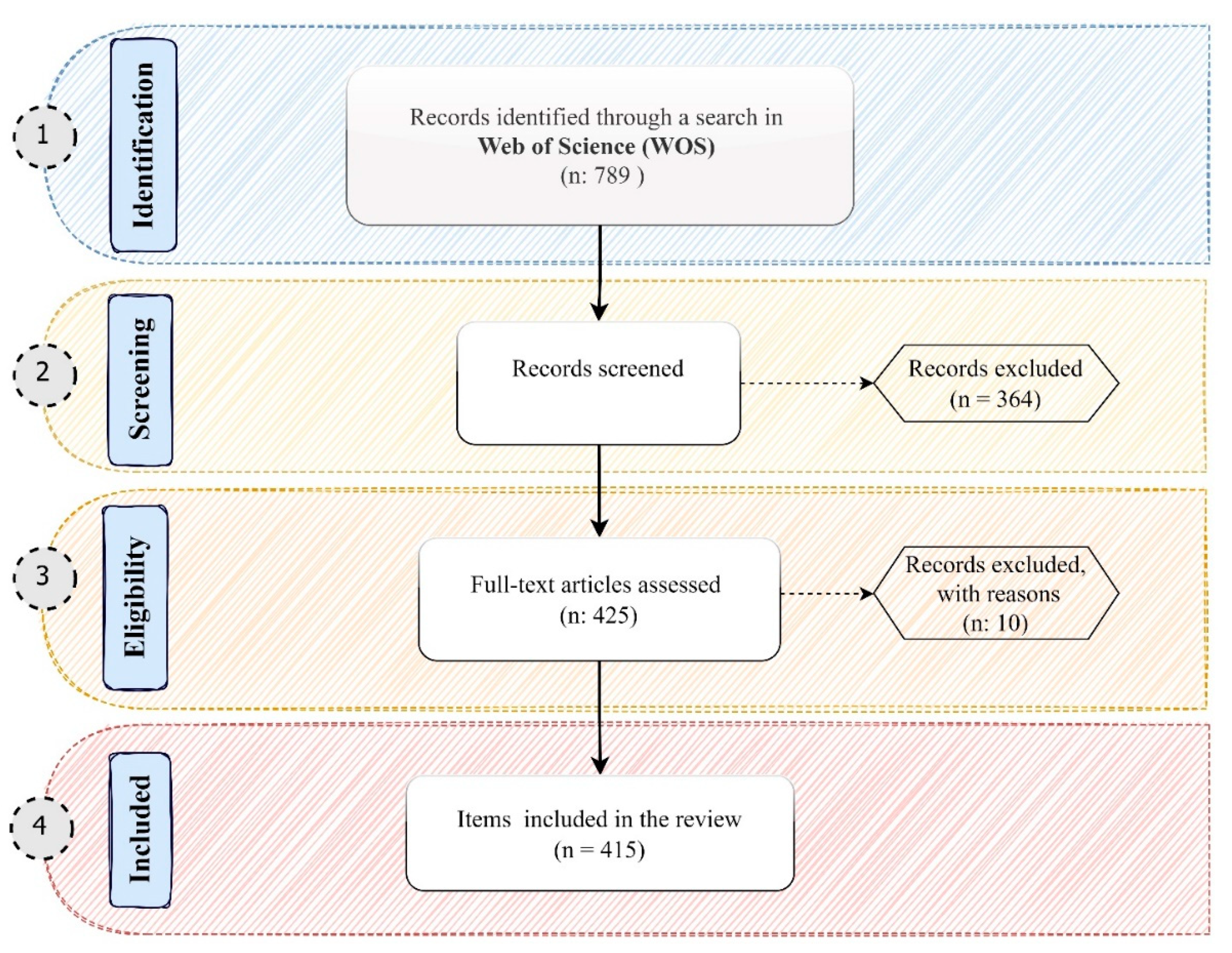
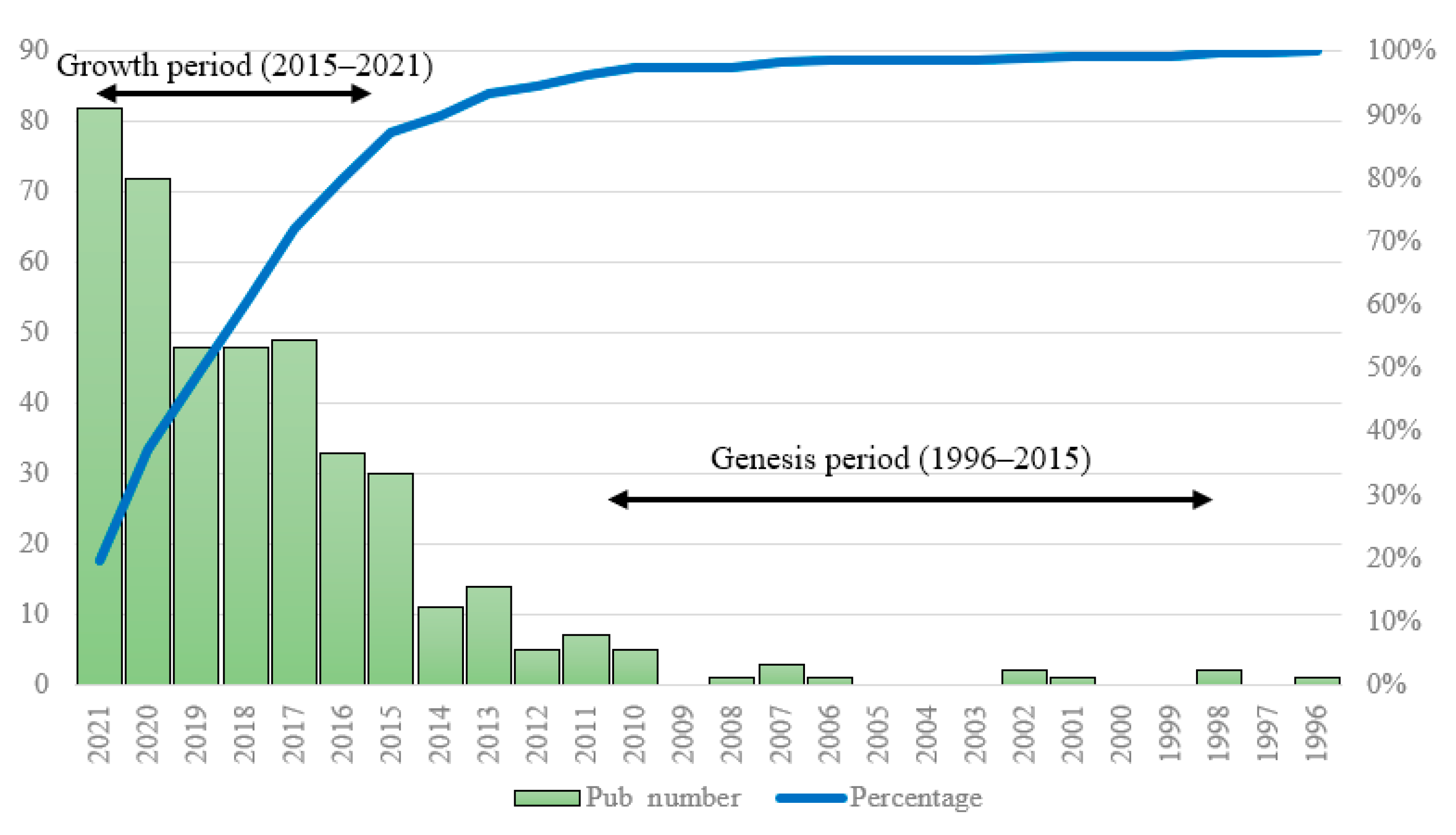
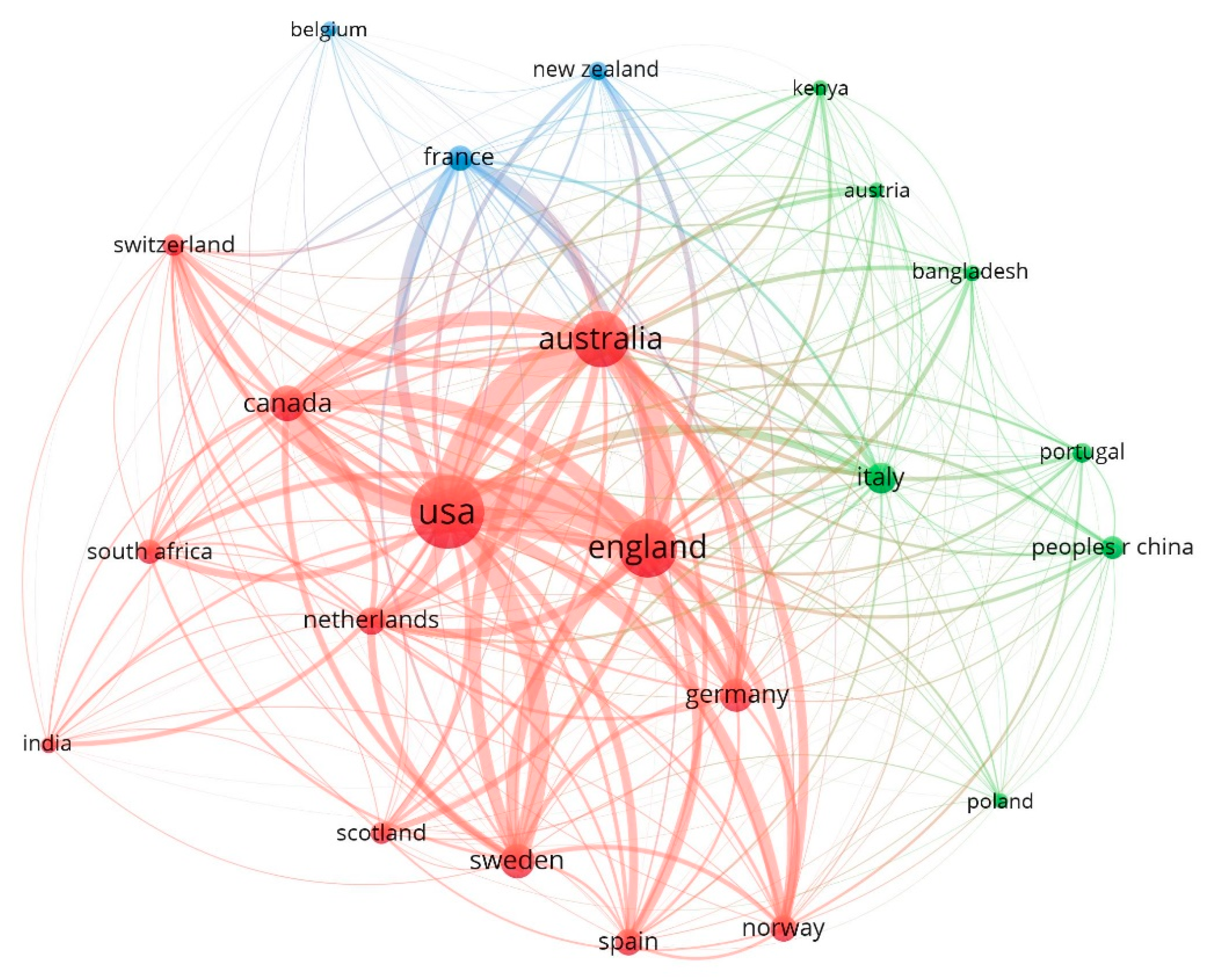
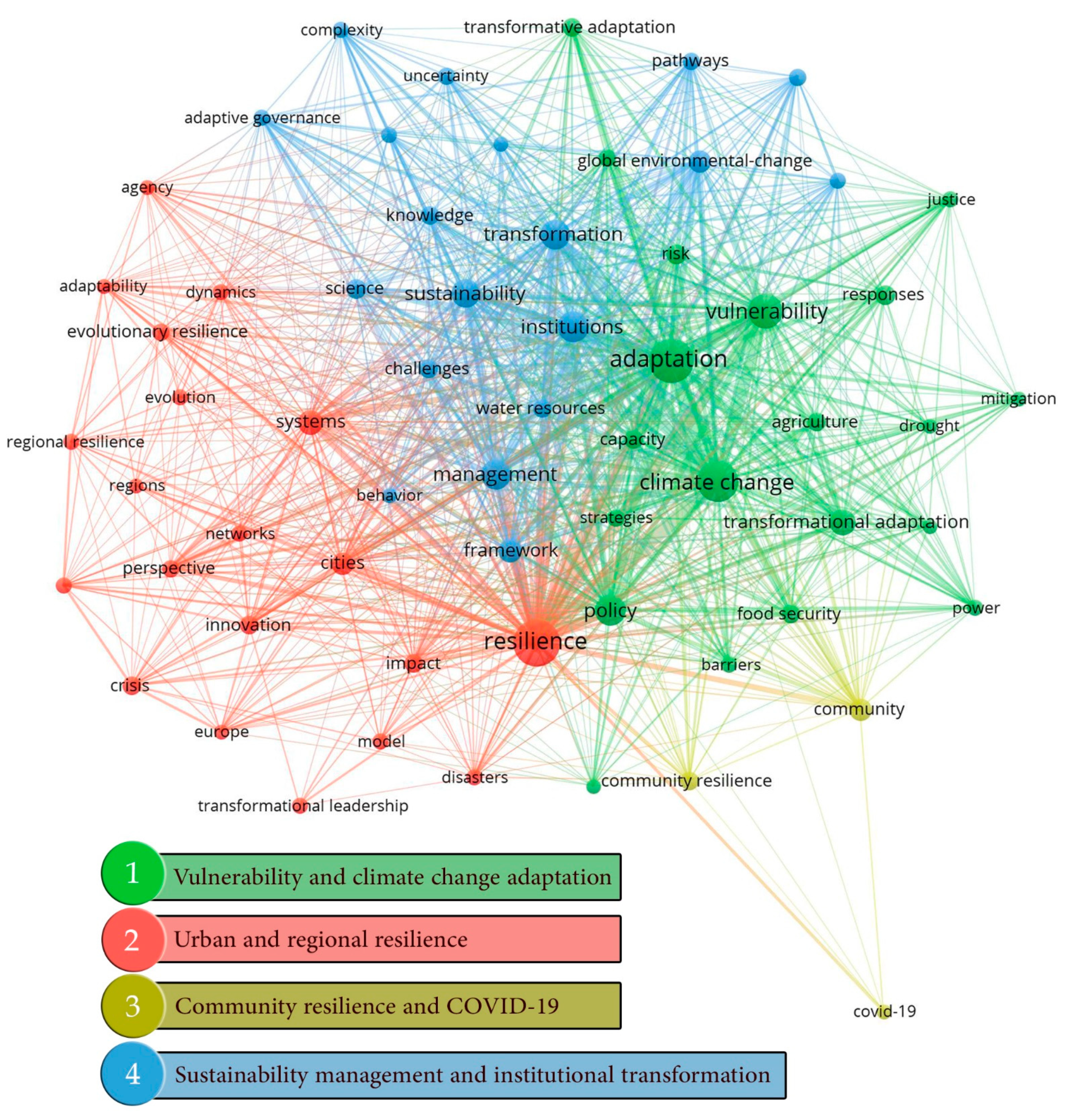
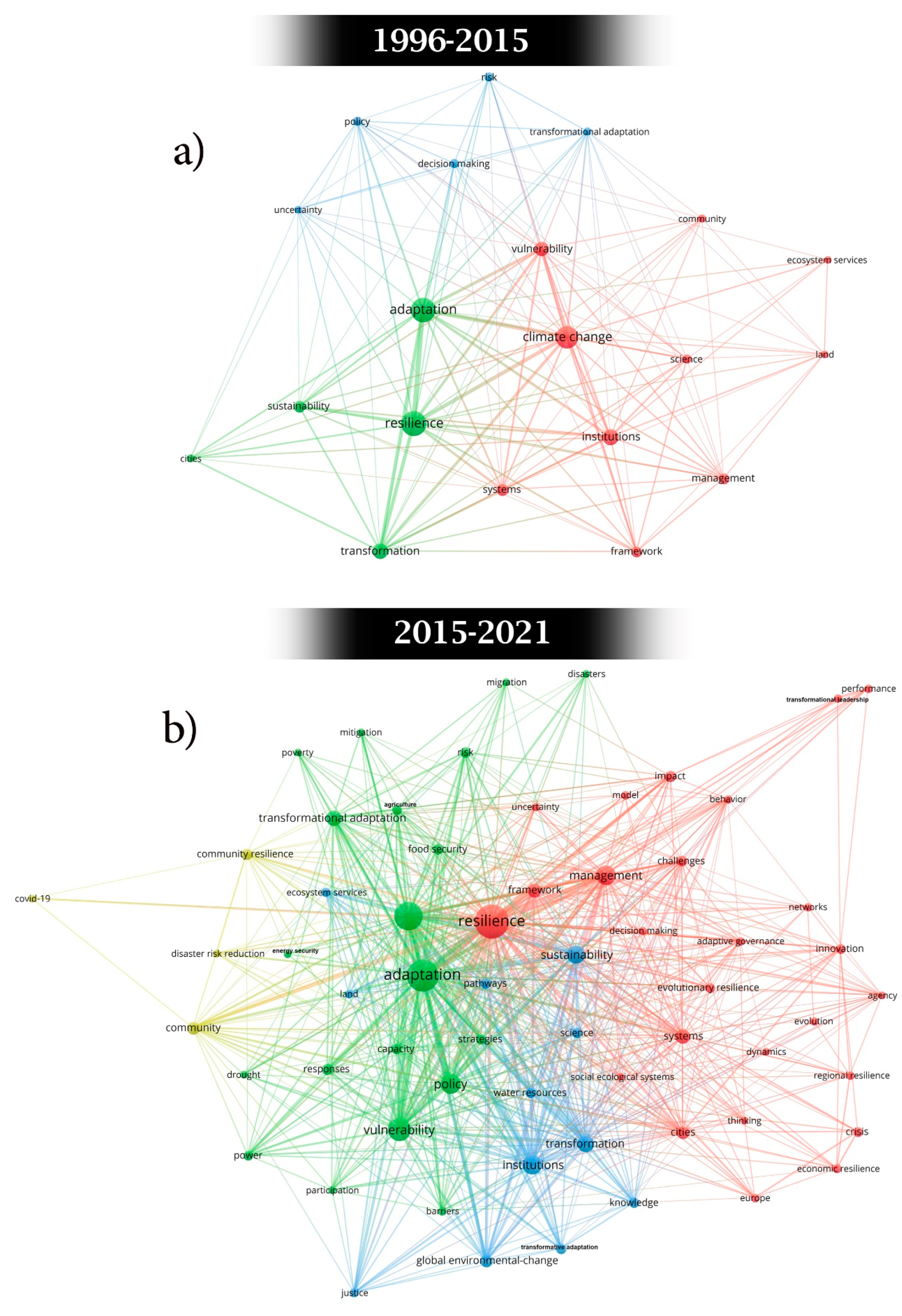
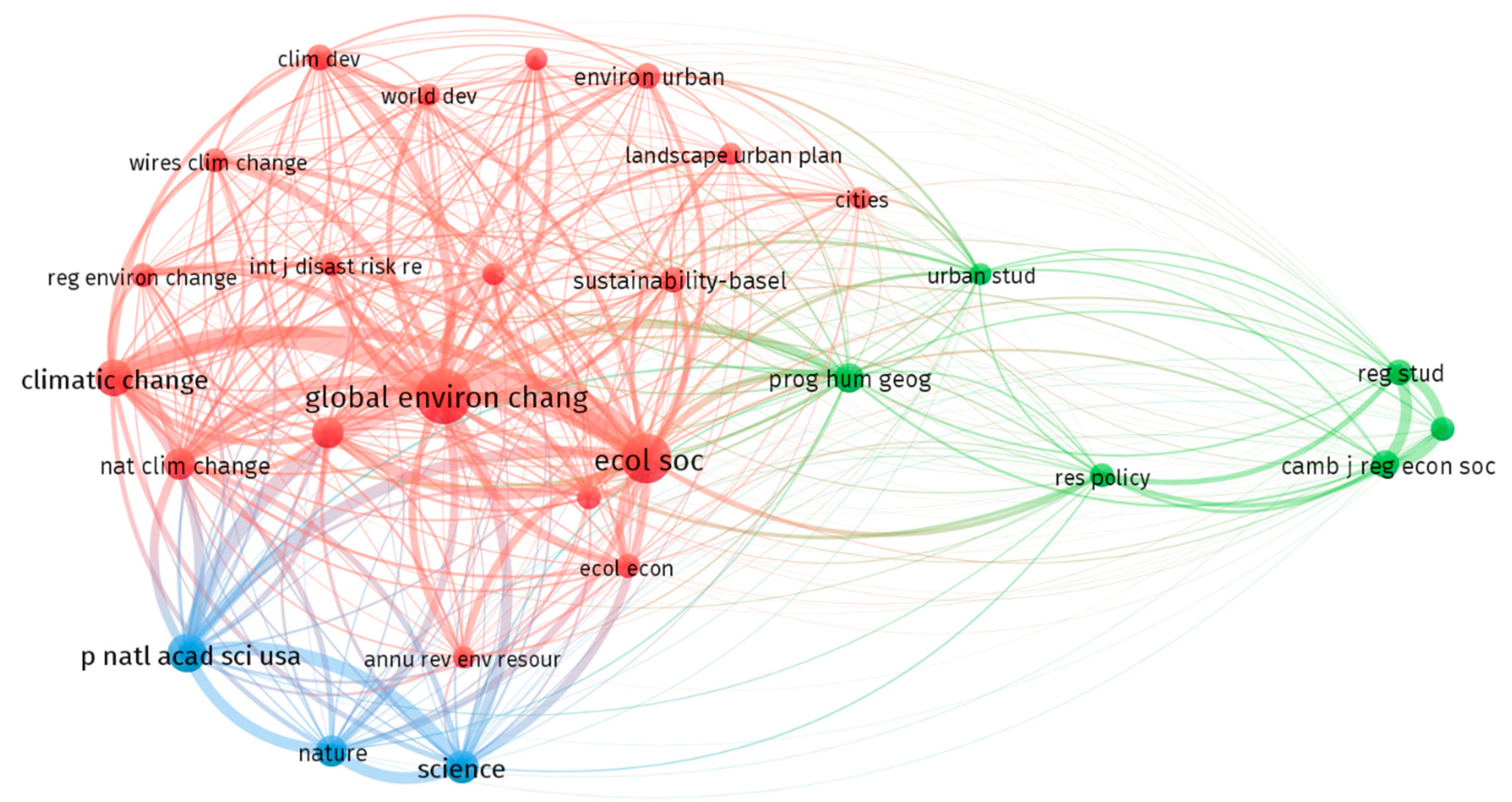

| Categories | 1996–2015 | 2015–2021 | Total | |||
|---|---|---|---|---|---|---|
| N | % | N | % | N | % | |
| Publications | 96 | 23 | 319 | 77 | 415 | 100 |
| Document types | ||||||
| Article | 74 | 70 | 266 | 84 | 340 | 81.9 |
| Proceeding paper | 9 | 12 | 18 | 6 | 27 | 6.5 |
| Review | 8 | 11 | 34 | 10 | 42 | 10.1 |
| Book chapter | 5 | 8 | 1 | 0.3 | 6 | 1.4 |
| Subject areas | ||||||
| Environmental sciences ecology | 36 | 38 | 145 | 45 | 181 | 44 |
| Geography | 9 | 9 | 32 | 10 | 41 | 10 |
| Business economics | 8 | 8 | 26 | 8 | 34 | 8 |
| Urban studies | 4 | 4 | 24 | 8 | 28 | 7 |
| Public administration | 5 | 5 | 23 | 7 | 28 | 7 |
| Other areas | 34 | 35 | 69 | 22 | 103 | 24 |
| Journals | ||||||
| Sustainability | 0 | 0 | 22 | 7 | 22 | 5 |
| Environmental science policy | 2 | 2.8 | 13 | 4 | 15 | 4 |
| Global environmental change | 6 | 6.2 | 11 | 3 | 17 | 4 |
| International journal of disaster risk reduction | 0 | 0 | 11 | 3 | 11 | 3 |
| Other journals | 88 | 91 | 262 | 82 | 350 | 84 |
| Country | ||||||
| USA | 25 | 26 | 102 | 32 | 125 | 30 |
| Australia | 19 | 20 | 50 | 16 | 70 | 17 |
| England | 14 | 15 | 56 | 18 | 70 | 17 |
| Germany | 4 | 4 | 29 | 9 | 34 | 8 |
| Canada | 4 | 4 | 27 | 8 | 31 | 7 |
| Other countries | 30 | 31 | 55 | 17 | 85 | 20 |
| Funding agencies | ||||||
| National Science Foundation NSF | 13 | 38 | 39 | 35 | 48 | 36 |
| European Commission | 5 | 15 | 31 | 28 | 34 | 25.6 |
| UK Research Innovation UKRI | 16 | 47 | 24 | 22 | 34 | 25.6 |
| “National Natural Science” “Foundation of China NSFC” | 0 | 0 | 17 | 15 | 17 | 12.8 |
| Most published authors | ||||||
| Folke C | 6 | |||||
| Ziervogel G | 5 | |||||
| Colloff MJ | 5 | |||||
| Wamsler, C | 5 | |||||
| Most cited authors | ||||||
| Adger, N | 201 | |||||
| Folke, C | 182 | |||||
| Pelling, M | 177 | |||||
| Influential Documents | Authors/Year | Highlighted Terms | Transformative Resilience Discourse | Target of Transformation |
|---|---|---|---|---|
| “Transformational adaptation when incremental adaptations to climate change are insufficient.” “Adaptation to climate change: From resilience to transformation.” “Global environmental change II: From adaptation to deliberate transformation.” | [24] [23] [56] | Adaptation Climate Change Vulnerability | Disaster risk reduction (DRR) | Urban and regional resilience |
| “Resilience and Stability of Ecological Systems “ “Resilience: The emergence of a perspective for social-ecological systems analyses.” | [122] [54] | Resilience Systems Crisis | Social-ecological systems (SES) | Climate change adaptation |
| “Resilience: A Bridging Concept or a Dead End?” | [55] | Institutions Management Sustainability | Development | Sustainability management and institutional transformation |
Publisher’s Note: MDPI stays neutral with regard to jurisdictional claims in published maps and institutional affiliations. |
© 2022 by the authors. Licensee MDPI, Basel, Switzerland. This article is an open access article distributed under the terms and conditions of the Creative Commons Attribution (CC BY) license (https://creativecommons.org/licenses/by/4.0/).
Share and Cite
Asadzadeh, A.; Khavarian-Garmsir, A.R.; Sharifi, A.; Salehi, P.; Kötter, T. Transformative Resilience: An Overview of Its Structure, Evolution, and Trends. Sustainability 2022, 14, 15267. https://doi.org/10.3390/su142215267
Asadzadeh A, Khavarian-Garmsir AR, Sharifi A, Salehi P, Kötter T. Transformative Resilience: An Overview of Its Structure, Evolution, and Trends. Sustainability. 2022; 14(22):15267. https://doi.org/10.3390/su142215267
Chicago/Turabian StyleAsadzadeh, Asad, Amir Reza Khavarian-Garmsir, Ayyoob Sharifi, Pourya Salehi, and Theo Kötter. 2022. "Transformative Resilience: An Overview of Its Structure, Evolution, and Trends" Sustainability 14, no. 22: 15267. https://doi.org/10.3390/su142215267
APA StyleAsadzadeh, A., Khavarian-Garmsir, A. R., Sharifi, A., Salehi, P., & Kötter, T. (2022). Transformative Resilience: An Overview of Its Structure, Evolution, and Trends. Sustainability, 14(22), 15267. https://doi.org/10.3390/su142215267








